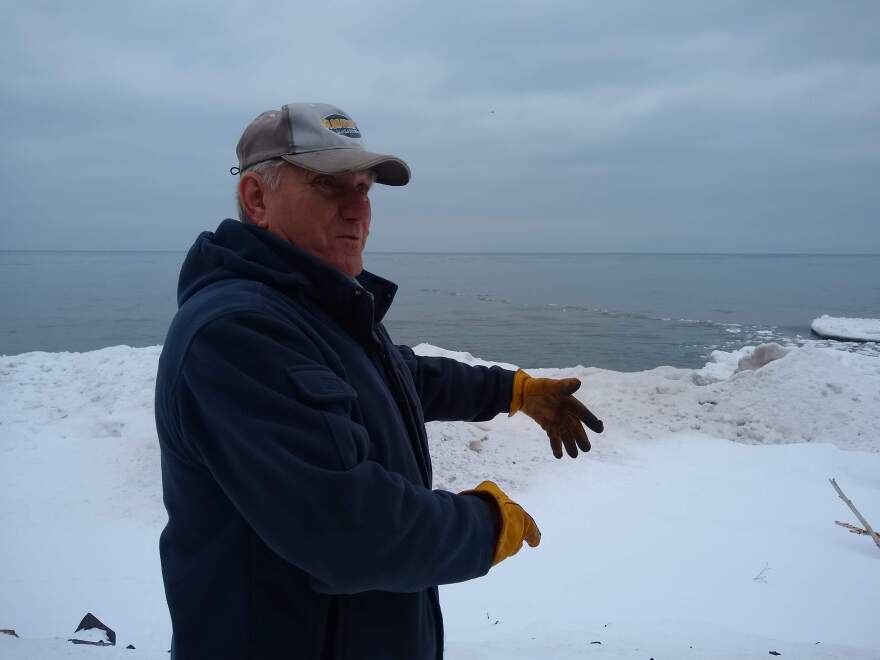It’s not difficult for Norm Pestka to picture what used to be here.
After all, the land that’s now underwater was dry just a few months ago.
“It’s been fine here for years. They lost 45 feet in one storm. The beach was out there, literally,” Pestka said, motioning to a patch of Lake Superior now submerged.

Pestka is standing on private land just outside Ontonagon in Michigan’s Upper Peninsula. Lake Superior stretches out before him. It’s mostly open water, save for some ice, snow, and floating ice chunks near the shore.
“This cabin was sitting right here, and this wall was right straight down,” Pestka said of the site. “It would have fell in [if we didn’t move it].”
Pestka owns an Ontonagon-based construction company. It’s been busy working on shoreline erosion control in the area as lake levels remain at or near record highs. Recent storms have led to massive erosion and land falling into the water.
“Is this trial and error?” Pestka asked rhetorically. “Yeah, because we don’t know what Mother Nature’s going to do.”
As Pestka spoke, heavy machinery moved one-ton boulders into place. They serve as armor against further erosion.

Jim Caron, who works on the permitting staff for Michigan’s Department of Environment, Great Lakes, and Energy, was overseeing the placement of the huge rocks.

“The idea there is we have a very powerful body of water here and you need something large to keep it in place from eroding,” Caron said.
Caron has seen pictures of homes falling off cliffs across the state, including on the Lake Michigan and Lake Huron shorelines. But don’t blame the homeowners for building in a poor place, he said.
“To no fault of their own, the shorelines eroding to the extent that they had after one or two storm events, has made it not only a priority, but really a crisis,” said Caron.
Caron said Lake Superior’s heightened water level has been causing major issues for three years now. The lake stands 15 inches higher than normal for January.
Lakes Michigan and Huron are more than three feet above their average.
“Lake Superior and Lake Michigan, if the trend continues for the next few days in the month of January, will break their all-time record for the highest water level in the month of January,” said Mike Celletti, a meteorologist for the National Weather Service in Green Bay.
When the Great Lakes are mostly ice-free, the open water aids evaporation and helps ease lake levels. The lakes are ice-free so far this winter, but the outlook is still concerning.
“They’re forecasting water levels to remain above records for the rest of this winter and through spring into the early start of the summer,” Celletti said.

To protect properties from those lake levels, Michigan is expediting erosion control permits like the one given to Pestka by Caron.
“They’ve told staff, ‘Give them a priority. Process them as quickly as you can.’ We’ve been processing them in as little as just a business day or two,” Caron said.
Between Oct. 1 and Jan. 22, Michigan regulators got nearly 600 shoreline applications. That’s on pace to more than double the number from the previous October-to-September time period.
Staff are working nights and weekends to process the applications.
The Wisconsin Department of Natural Resources also has an emergency permitting system in place.

Fifteen miles west of the private property near Ontonagon, Pestka visits another one of his shoreline-saving projects.
It’s Highway 107, the main entrance road to Michigan’s largest state park, Porcupine Mountains Wilderness State Park, which draws more than 300,000 visitors yearly.
This road almost disappeared.
“Before we had the erosion problems two years ago, which was when it was bad in [2017-2018], there was probably 30 or 40 feet of beach out here,” Pestka said.
Pestka’s company put in erosion-blocking riprap, which kept Lake Superior at bay. However, the water now nearly reaches Highway 107.
“You had here a jewel, really, of the U.P., that was in danger of being inaccessible to people,” Caron said.
No matter how much planning is done, how many emergency permits are issued, or how many boulders are rolled into place, these men know one thing.
Mother Nature remains in charge.
“If there’s no other lesson learned, it’s that we have to realize that you can’t ever sit back and think, ‘That’s good enough.’ I don’t think there’s a ‘good enough.’ You have to plan for the worst-case scenario,” Caron said.

High water levels all around the Great Lakes continue to cause problems.
On Tuesday, Wisconsin Gov. Tony Evers asked the Federal Emergency Management Agency for a damage assessment on the Lake Michigan shoreline of Milwaukee, Racine, and Kenosha counties.
Storms and flooding have caused an estimated $30 million in damage to public infrastructure in those areas.








